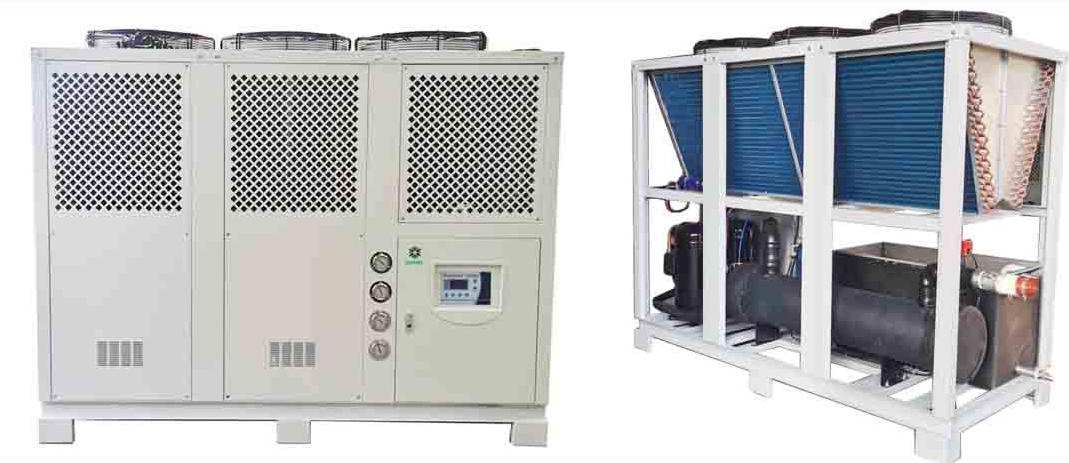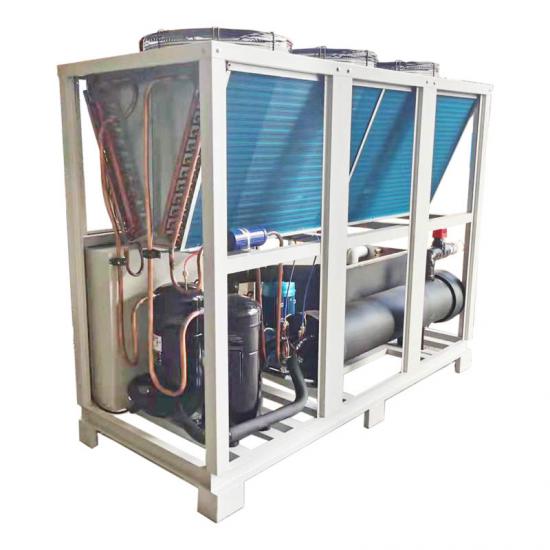Categories
New Blog
How Air Cooled Chiller Improves Blow Molding Machine Output
Nov 20, 2025How Air Cooled Chiller Improves Blow Molding Machine Output
Air cooled chillers give you:
Faster production cycles
Higher product quality
Fewer machine stoppages
Lower operating costs
|
Benefit |
Description |
|---|---|
|
Improved Cooling Efficiency |
Enhances the cooling process for better temperature control |
|
Reduced Cycle Times |
Speeds up production by shortening cooling durations |
|
Enhanced Product Quality |
Reduces defects for higher quality molded products |
Specialized chillers help you keep temperature steady, so you maintain consistent output and quality.

You need precise temperature control to achieve high efficiency in blow molding. When you keep the temperature steady, you ensure the plastic melts and flows with uniform viscosity. This consistency helps prevent defects and keeps your production running smoothly. Advanced control systems let you monitor temperature in real time, so you can quickly adjust settings and avoid errors.
Cooling plays a major role in your production speed. In many cases, the cooling phase makes up more than 60% of the total molding cycle. For larger or thicker products, this number can reach up to 90%. If you improve cooling efficiency, you can shorten the cycle time and increase your output. High mold temperatures slow down cooling, which leads to longer cycles and lower productivity. By optimizing your cooling process, you can boost your production rates and reduce downtime.
Here is a table showing how cooling time affects your production:
|
Evidence |
Explanation |
|---|---|
|
Cooling time accounts for more than 60% of the entire molding cycle. |
Any change in cooling rate directly affects cycle time and productivity. |
|
Longer cooling times lead to increased cycle times and decreased productivity. |
Inefficient cooling slows down your output. |
|
Improved cooling efficiency can shorten the cycle time. |
Optimized cooling boosts your overall production. |
Temperature stability is key to producing high-quality blow molded products. When you maintain the right temperature, you prevent defects and ensure each product meets your standards. The recommended temperature range depends on the material you use:
|
Material |
Recommended Temperature Range |
|---|---|
|
General |
180 ℃ to 220 ℃ |
|
HDPE |
170 ℃ to 210 ℃ |
|
TPV |
170 ± 10 ℃ (drying) |
You also need to consider the heat resistance of your products. Heat resistance helps your products keep their shape, strength, and function when exposed to high temperatures. The type of plastic resin you choose affects this property. For example, PET offers good heat resistance, while HDPE has lower resistance. You can use additives like heat stabilizers to improve performance during exposure to heat.
Heat resistance maintains product shape and strength.
Resin type influences how well your product handles heat.
Additives can boost heat resistance and prevent degradation.
By focusing on precise temperature control and efficient cooling, you can achieve both higher output and better product quality in your blow molding operations.
You need to understand how air-cooled chillers operate to get the most from your blow molding machines. These chillers remove heat from your process by circulating chilled water through the system. The chilled water absorbs heat from the blow molding machine and then returns to the chiller, where the heat is released into the surrounding air. This process keeps your equipment at the right temperature, which is essential for consistent production.
The 15 Ton Air Cooled Chiller by Oumal Chiller is a specialized solution for blow molding applications. It uses Copeland scroll compressors, which offer high efficiency and flexible performance. These compressors adjust to different cooling loads, so you always get the right amount of cooling. The chiller also features a choice of evaporators, such as shell and tube or plate heat exchangers, and a 304 stainless steel water tank for durability.
Here is a table showing the main components of an air-cooled chiller:
|
Component |
Description |
|---|---|
|
Compressor |
Drives refrigerant flow; types include scroll, screw, and reciprocating. |
|
Condenser |
Transfers heat from refrigerant to air. |
|
Fans |
Move air across the condenser to remove heat. |
|
Expansion Valves |
Control refrigerant flow and pressure. |
|
Evaporator |
Absorbs heat from the process water. |
|
Filter Drier |
Removes impurities and moisture for system protection. |
Setup and Maintenance Advantages
You will find that air-cooled chillers offer several advantages during installation and maintenance. Unlike traditional water-cooled systems, air-cooled chillers do not need cooling towers or extra piping. This makes installation faster and more cost-effective. You can place these chillers outdoors, which saves valuable indoor space and works well for facilities with limited room.
The 15 Ton Air Cooled Chiller by Oumal Chiller stands out for its easy setup and low maintenance needs. The stainless steel water tank resists corrosion, and the system includes multiple safety protections. You spend less time on upkeep because there are fewer components to service.
Here is a table comparing maintenance requirements:
|
System Type |
Maintenance Requirements |
|---|---|
|
Air-Cooled Chillers |
Lower maintenance; no cooling towers required. |
|
Water-Cooled Chillers |
Higher maintenance; needs cooling towers, water treatment, and regular cleaning. |
You also benefit from energy-saving features. The Copeland scroll compressors and efficient fans help reduce electricity use. Air-cooled chillers provide a water-saving alternative, which is ideal for areas where water is scarce or expensive.
Output Enhancement with Air-Cooled Chiller

You can achieve faster cycle times in your blow molding process by using air-cooled chillers. These chillers deliver precise and consistent cooling, which keeps your mold temperatures at the ideal level. When you maintain optimal mold temperatures, you reduce the time needed for each cycle. This leads to more products made in less time.
Air-cooled chillers circulate cooled water through your molds. This process removes heat quickly and prevents overheating. If your molds get too hot, you must increase cooling time to avoid defects. That slows down your production. With an air cooled chiller, you keep your molds at the right temperature and avoid unnecessary delays.
Efficient cooling systems, like air-cooled chillers, are crucial for reducing cycle times in blow molding operations. Proper temperature management also prevents issues like mold sweating, which can extend cycle times. Here are some key points to remember:
Air-cooled chillers provide precise and consistent cooling, essential for optimal mold temperatures.
Maintaining the right temperature reduces cycle times and speeds up production.
High mold temperatures slow down production because you need longer cooling times to prevent defects.
Chillers circulate cooled water, ensuring efficient heat removal and preventing overheating.
You can see the benefits in the table below:
|
Benefit |
Description |
|---|---|
|
Reduces Scrap Count |
A consistent temperature supply leads to less scrap production. |
|
Better Heat Transfer |
Closed water loops improve heat transfer, reducing maintenance and downtime. |
|
Colder Water |
Chillers can produce colder water than other cooling methods, enhancing cooling efficiency. |
Consistent Quality
You can improve product consistency by integrating air-cooled chillers into your blow molding operation. Reliable temperature control ensures that every product meets your quality standards. When you keep the temperature steady, you avoid defects like warping, bubbles, or uneven thickness.
Air-cooled chillers adapt quickly to changes in demand. This flexibility helps you maintain uninterrupted production. You get smoother workflows and fewer quality issues. Consistent cooling also means your products have uniform strength and appearance.
Reduced Downtime
You can minimize downtime in your plant by using air-cooled chillers. These chillers come with advanced safety protections, such as compressor overheating protection, high and low-pressure safeguards, and flow protection. Each chiller undergoes factory testing under load conditions, so you know it will perform reliably.
A real-world example comes from a plastics manufacturing plant in Buckeye, Arizona. The facility installed high-efficiency air-cooled chillers with variable speed compressors and individual PLC controls. This setup reduced water consumption and improved machine performance. As a result, the plant experienced less downtime and more efficient production.
Closed water loops in air-cooled chillers also improve heat transfer. This reduces the need for maintenance and keeps your machines running longer without interruption.
You can achieve significant energy efficiency and cost savings with air-cooled chillers. These chillers use advanced compressors and efficient fans to lower electricity use. You do not need a cooling tower, which reduces installation and maintenance costs.
Here is a comparison of operational costs:
|
Chiller Type |
Initial Investment Cost |
Operational Cost Implications |
|---|---|---|
|
Air-Cooled Chillers |
Lower |
Higher in warmer climates due to decreased efficiency. |
|
Water-Cooled Chillers |
Higher |
Generally lower operational costs but complex maintenance. |
Air cooled chiller systems help you save water, which is important in areas where water is expensive or limited. By choosing energy-efficient chillers, you lower your utility bills and reduce your environmental impact.
You gain more than just lower costs. You also get a reliable system that supports your production goals and keeps your operation running smoothly.
Choosing the right chillers for your blow molding machines starts with understanding your process needs. You want chillers that match your production demands and deliver reliable performance. Follow these steps to make the best choice:
Calculate Your Cooling Load: Determine how much heat your process generates. Consider the material throughput and the temperature of your workspace.
Identify Fluid and Flow Needs: Know the type of fluid your cooling systems will use and the flow rate required to remove heat efficiently.
Assess Environmental Factors: Check the ambient temperature and altitude of your facility. These factors affect how well chillers perform.
Select the Right Chiller Type: Decide if you need portable, stationary, or custom chillers based on your plant layout and production scale.
Consult with Experts: Work with manufacturers to verify your calculations and ensure you choose the correct size and type of chillers.
You need to look at several features when comparing chillers for blow molding. The cooling capacity must match the heat load from your machines. Compressor type plays a big role in efficiency and reliability. Scroll compressors, for example, offer high performance and low maintenance.
Evaporator design also matters. High-efficiency seamless copper tubes and grooved surfaces increase heat transfer, helping your cooling equipment maintain steady mold temperatures. Good insulation and baffle plates further optimize the cooling process.
Safety features protect your investment and keep your operation running smoothly. Look for chillers with:
|
Safety Feature |
Description |
|---|---|
|
Flow Safety Thermostat |
Detects temperature changes and stops coolant flow to prevent overheating. |
|
Freeze Safety |
Prevents refrigerant from freezing and resets automatically. |
|
Liquid Flow Switch |
Stops flow if fluid volume drops, protecting the evaporator. |
|
Compressor Safety Features |
Guards against pressure changes that could damage the unit. |
Factory testing ensures each chiller meets strict standards before it arrives at your plant. You get peace of mind knowing your cooling systems will perform as expected.
When you need a tailored solution, consult with manufacturers like Oumal Chiller. They offer custom designs, including explosion-proof and stainless steel chillers, to fit your specific needs. Their experience and commitment to customer satisfaction help you get the most from your cooling equipment.